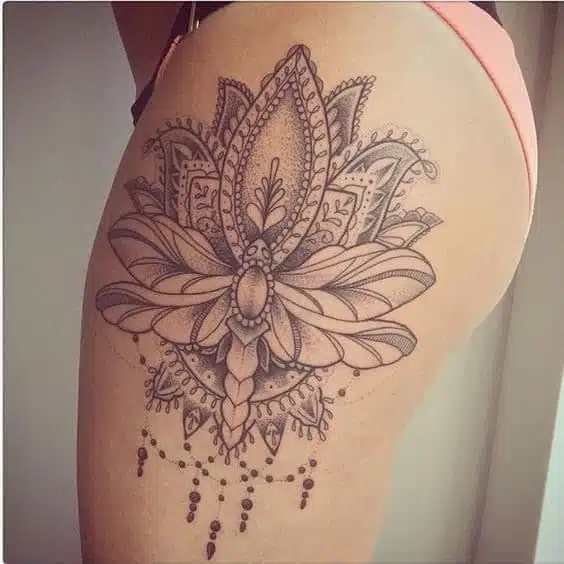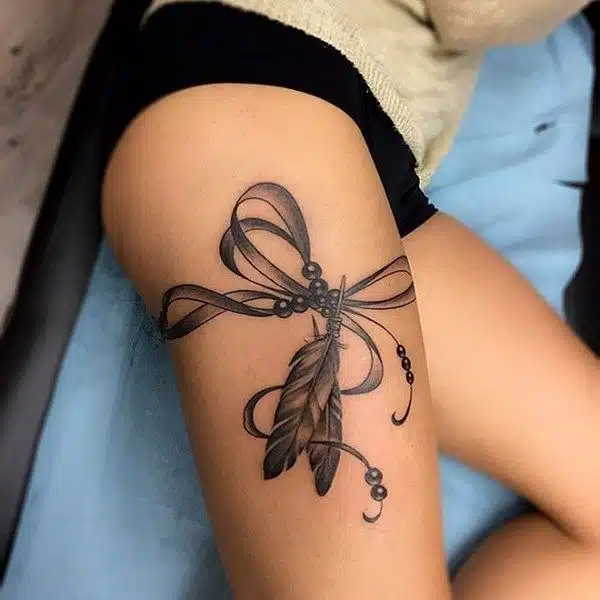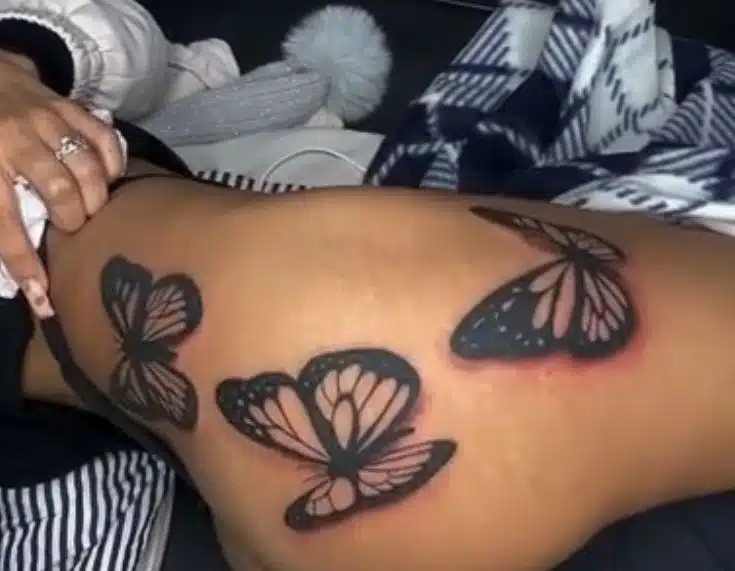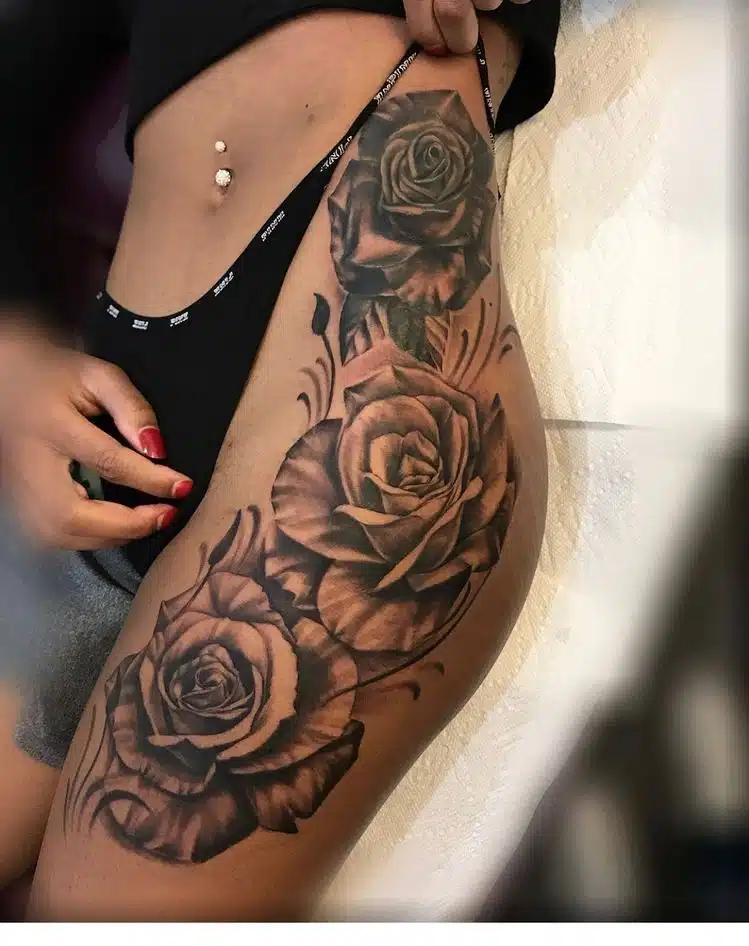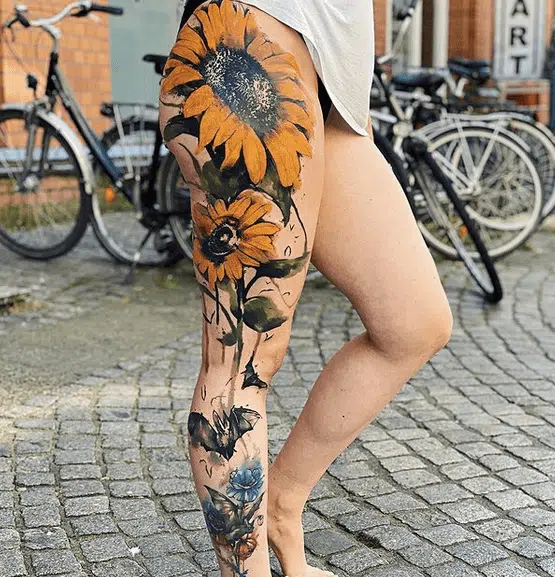If you're looking for a new tattoo and are considering getting something on your thigh, you'll want to check out this list of beautiful side thigh tattoos for women! These designs are all incredibly unique and stylish and will make you stand out from the crowd. Whether you're into delicate designs or want something more bold and eye-catching, we've covered you. So if you're ready to find your perfect side thigh tattoo, keep reading!
Are you only interested in tattoo designs and want to skip the educational part?
No problem, we got you covered! Click HERE to get inspired.
What Do Side Thigh Tattoos symbolize on women?
The symbolism of side thigh tattoos on women can vary depending on the individual and the specific design chosen. Tattoos are highly personal and can hold different meanings for different people. However, here are some common interpretations and symbolism associated with side thigh tattoos on women:
Femininity and sensuality: The side thigh is often considered an intimate and sensual area, and women may choose tattoos in this location to celebrate their femininity and embrace their sexuality.
Empowerment and self-expression: Tattoos, in general, can be a form of self-expression and a way to assert one's identity. Side thigh tattoos can symbolize empowerment, as they are often visible when wearing certain clothing, allowing women to proudly display their body art.
Beauty and aesthetics: The side thigh is an attractive and visually appealing location for tattoos. Women may choose tattoos in this area to enhance the beauty of their body and create an aesthetically pleasing composition.
Personal significance: Side thigh tattoos can hold personal meaning for the wearer. They may represent significant life events, commemorate loved ones, convey personal beliefs or values, or serve as a reminder of a particular journey or experience.
Freedom and rebellion: In some cases, side thigh tattoos can symbolize a sense of freedom and rebellion. Women may choose tattoos in this area as a way to break societal norms or express their independence.
What does the thigh area symbolize for women?
The thigh area can hold different symbolic meanings for women, both culturally and personally. Here are some common interpretations associated with the thigh area:
Strength and power: The thigh muscles are some of the strongest muscles in the body, and they play a significant role in movement and physical strength. As a result, the thigh area can symbolize strength, power, and physical capability for women.
Sensuality and femininity: The thigh area is often considered an intimate and sensual part of a woman's body. Its curves and contours can be seen as symbols of femininity, and many women embrace this aspect of their body when it comes to self-expression and personal empowerment.
Beauty and attractiveness: The thigh area is often associated with beauty and attractiveness. It is a visually appealing part of the body and can be accentuated through various fashion choices, such as skirts, dresses, or shorts. Women may view the thigh area as a symbol of their physical beauty or appreciate its aesthetic qualities.
Body confidence and acceptance: The thigh area, like any part of the body, can be a source of self-consciousness or insecurity for some women. However, many women also view the thigh area as a symbol of body confidence and acceptance. Tattoos or other forms of adornment on the thighs can serve as a way to embrace and celebrate their bodies.
Freedom and liberation: In some contexts, the thigh area has been associated with notions of freedom and liberation. For example, historically, women's clothing has often restricted their movement and covered their legs. However, embracing and revealing the thigh area can be seen as an act of breaking free from societal expectations and embracing personal freedom.
The considerations for getting a side thigh tattoo
Before getting a side thigh tattoo, there are several important factors to consider. Here are some key considerations:
Design and Placement: Think about the specific design and placement of the tattoo on your side thigh. Take your time to research and select a design that holds personal significance to you. Consider how it will look in that specific area and how it complements your body shape. Ensure that the size and shape of the design fit well on your side thigh and consider how it may interact with other existing or future tattoos on adjacent areas.
Pain and Sensitivity: Keep in mind that the side thigh can be a sensitive area for some people, and the pain level during the tattooing process may vary. Take into account your pain tolerance and how comfortable you are with potential discomfort. It may be helpful to consult with your tattoo artist about pain management techniques or consider starting with a smaller design if you're uncertain about your pain tolerance.
Clothing and Visibility: Consider how your side thigh tattoo may affect your choice of clothing and its visibility. Side thigh tattoos can be visible in certain outfits, such as swimwear, shorts, or skirts. If you work in a professional setting or have specific dress code requirements, think about how the tattoo may be perceived in those contexts. Assess whether you are comfortable with its visibility in different situations and if it aligns with your personal and professional goals.
Long-Term Commitment: Tattoos are a permanent form of body art, so it's important to carefully consider the long-term commitment involved. Think about how the tattoo may age over time and whether you will still resonate with the design and its meaning in the future. Reflect on your willingness to embrace the tattoo as a part of your identity throughout your life.
Tattoo Artist Selection: Choosing a skilled and reputable tattoo artist is crucial. Research tattoo artists who specialize in the style and design you have in mind. Look at their portfolio, read reviews, and ensure they follow proper hygiene and safety protocols. Schedule a consultation with your chosen artist to discuss your ideas, ask questions, and assess their professionalism and expertise.
Aftercare and Healing: Understand the aftercare instructions for your tattoo and be prepared to follow them diligently. The side thigh can be prone to friction and movement, so it's important to take extra care during the healing process. Follow your tattoo artist's recommendations for cleaning, moisturizing, and protecting the tattooed area to promote proper healing and minimize the risk of infection.
Best Side Thigh Tattoos For Women and their meanings
Lotus Flower Thigh Tattoo
The lotus flower is a popular choice for side thigh tattoos as it symbolizes beauty, purity, and new beginnings. This tattoo can represent your journey of self-discovery and growth, or it can be a reminder always to stay positive no matter what life throws your way.
Feather Thigh Tattoo
Feather tattoos are often chosen for their delicate and feminine design, but they can also represent freedom, hope, and new beginnings. If you're someone who loves to travel or feels a strong connection to nature, a feather tattoo might be the perfect choice for you.
Butterfly Thigh Tattoo
Butterflies are another popular choice for side thigh tattoos, and they can symbolize transformation, new beginnings, and the beauty of nature. If you're looking for a tattoo representing your personal growth, a butterfly design may be perfect.
Rose Thigh Tattoo
Roses are often associated with love, passion, and romance, making them a popular choice for side thigh tattoos. If you're in love or want to show your feminine side, a rose tattoo may be the perfect design.
Sunflower Thigh Tattoo
Sunflowers are known for their bright and cheerful appearance, making them a popular choice for tattoos. They can represent happiness, positivity, and new beginnings and are perfect for anyone who wants a tattoo that will make them smile.
@hessom_va Proper way to tattoo a thigh #fyp #tattooartist #tattoo #tattoos #hessom ♬ BIG MAD - Ktlyn
General Breakdown Of Tattoo Pain Levels On Different Body Parts
Here is a breakdown of the different tattoo pain levels:
- Low: This level of pain is generally described as a mild discomfort or tickling sensation. It is similar to the sensation of getting a light scratch or scrape.
- Moderate: This level of pain is generally described as a moderate discomfort or aching sensation. It is similar to the sensation of getting a deep scratch or scrape or being pinched.
- High: This level of pain is generally described as a strong discomfort or throbbing sensation. It is similar to the sensation of getting a burn or being stung by a bee.
It's important to note that pain tolerance is highly individual and can vary greatly from person to person. Some people may find certain body parts more or less painful than others, and the same body part can be more or less painful for different people. Additionally, the level of pain can be affected by factors such as the size and location of the tattoo, the skill of the tattoo artist, and the individual's own pain threshold.
Tattoo placement pain level chart
Body Part | Pain Level | Explanation |
Forehead | Low | The forehead has few nerve endings, so it is not a particularly painful area. |
Eyebrows | Low | The eyebrows have few nerve endings, so the pain level is relatively low. |
Ear | Low | The ear is a relatively thin and fleshy area, so the pain level is low. |
Nostril | Low | The nostril is a small area with thin skin, so the pain level is low. |
Lip | Low to Moderate | The lip has more nerve endings than some other areas, so it may be slightly more painful. |
Cheek | Low to Moderate | The cheek has a moderate amount of nerve endings, so it may be slightly more painful. |
Moderate | The neck has a moderate amount of nerve endings, so it may be slightly more painful. | |
Moderate to High | The chest has a high concentration of nerve endings, so it can be quite painful. | |
Abdomen | High | The abdomen has a high concentration of nerve endings, so it can be quite painful. |
Back | High | The back has a high concentration of nerve endings, so it can be quite painful. |
Shoulders | High | The shoulders have a high concentration of nerve endings, so they can be quite painful. |
Upper Arms | Moderate to High | The upper arms have a moderate to high concentration of nerve endings, so they can be somewhat painful. |
Elbows | High | The elbows have a high concentration of nerve endings, so they can be quite painful. |
Forearms | Moderate | The forearms have a moderate concentration of nerve endings, so they are not as painful as some other areas. |
Hands | High | The hands have a high concentration of nerve endings, so they can be quite painful. |
Lower Arms | Low to Moderate | The lower arms have a lower concentration of nerve endings, so they are not as painful as some other areas. |
Wrists | Low | The wrists have a low concentration of nerve endings, so they are not very painful. |
Lower Back | High | The lower back has a high concentration of nerve endings, so it can be quite painful. |
Buttocks | High | The buttocks have a high concentration of nerve endings, so they can be quite painful. |
Thighs | High | The thighs have a high concentration of nerve endings, so they can be quite painful. |
Knees | High | The knees have a high concentration of nerve endings, so they can be quite painful. |
Calves | Low to Moderate | The calves have a low to moderate concentration of nerve endings, so they are not as painful as some other areas. |
Ankles | Low | The ankles have a low concentration of nerve endings, so they are not very painful. |
Tattoo aftercare tips
Before getting a tattoo:
Choose a reputable tattoo artist and parlor. Research the artist's portfolio and read reviews from previous clients.
Consult with the artist about the design and placement of the tattoo.
Make sure you are in good health. If you have any medical conditions or are taking any medications that may affect your ability to heal, be sure to let your tattoo artist know.
Consider using a numbing cream to reduce pain during the tattooing process. These creams contain a numbing agent (such as lidocaine) that can be applied to the skin before the tattoo is done. It's important to follow the instructions on the numbing cream and to only use it as directed.
Avoid alcohol, caffeine, and other substances that can thin your blood for at least 24 hours before getting a tattoo.
Eat a healthy meal before your tattoo session to ensure that your blood sugar is stable.
Wear loose, comfortable clothing that allows easy access to the area being tattooed.
After getting a tattoo:
Follow the aftercare instructions provided by your tattoo artist. These may include:
Keeping the tattoo clean and covered with a bandage for the first few hours after getting tattooed.
Washing the tattoo with lukewarm water and a mild soap (such as unscented, antimicrobial soap) and patting it dry with a clean towel.
Applying a thin layer of tattoo ointment or lotion (such as A&D or Aquaphor) to the tattoo and covering it with a clean bandage or wrap.
Repeating this process for the first few days, or until the tattoo has fully scabbed over.
Avoid soaking the tattoo in water for the first week, such as in a bath or pool.
Avoid picking or scratching at the scabs, as this can cause the tattoo to fade or become infected.
Avoid exposure to direct sunlight or tanning beds for at least 2-4 weeks.
If you experience any redness, swelling, or unusual discharge, contact your tattoo artist or a healthcare professional.
Overall, it's important to keep your tattoo clean and moisturized during the healing process to ensure that it heals properly and looks its best. Using a numbing cream can help reduce pain during the tattooing process, but it's important to use it as directed and to follow all aftercare instructions to ensure that your tattoo heals properly.
People Also Ask:
Do side thigh tattoos hurt?
This body region is well cushioned with fat and has few nerve endings. The upper outer thigh is one of the least painful places to get a tattoo, with pain levels ranging from low to moderate in most people.
Are thigh tattoos attractive?
Yes, thigh tattoos can be very attractive to both men and women. They can be placed in several ways, depending on your preference, and can be as small or large as you like.
Can guys have side thigh tattoos?
There's no reason why guys can't have side thigh tattoos! Many guys choose to get tattoos in this area as it can be a great place to show off their muscular build.
Do side thigh tattoos fade?
All tattoos will eventually fade over time, but side thigh tattoos may fade faster than other types of tattoos due to the amount of movement in this area of the body. If you want your tattoo to last, it's important to take proper care of it and avoid exposure to sunlight and other UV light sources.
Are thigh tattoos flattering?
Thigh tattoos can be very flattering on both men and women. They can help accentuate your body's curves and make your legs look longer and leaner.
Do side thigh tattoos stretch?
Like all tattoos, side thigh tattoos will stretch as your skin stretches. This is why choosing a design you're happy with is important, as it may not look the same years down the line.
How much do side thigh tattoos cost?
The cost of a side thigh tattoo will vary depending on the size, complexity, and location. Expect to pay anywhere from $50 to $500 for your tattoo, with larger and more detailed designs costing.
Do thigh tattoos age well?
The areas of the body that tend to age better with tattoos are flat surfaces like the forearm, upper arms, shoulders, back, and thighs. These places can usually take more wear and tear.
How do you sit for a thigh tattoo?
A thigh tattoo on the front might be viewed while you're resting flat on your back, which is one of the more relaxing session postures for thigh tattoo art. You may wish to apply a topical anesthetic to your thigh before your session or a numbing spray to decrease inflammation throughout the treatment.
Should I take painkillers before a tattoo?
Take pain relievers cautiously. For 24 hours before your procedure, don't take aspirin or ibuprofen. The blood may be thinned by these medications, delaying the tattooing process.
What should I wear after getting a thigh tattoo?
If you have a new tattoo on a covered body part, please avoid wearing tight clothing made of soft materials. After getting a thigh tattoo, for example, wearing jeans is not advised— instead, sweat pants or shorts are preferable.
Are thigh tattoos hard to heal?
Because tattoos on the thigh touch garments, you should look after them.
Thigh tattoos heal slower than other body parts, taking anywhere from three to four weeks. Under the skin, they can take up to three months to fully heal.
How do you sleep with a fresh thigh tattoo?
Most tattoo artists will tell you it's best to sleep with the wrap. Some suggest re-wrapping the tattoo, while others advocate for just applying healing ointment and keeping it clean. You must avoid infection.
How do you work out after a thigh tattoo?
Wait 48-72 hours before high-intensity or heavy sweating to avoid infections.
After the first six days, you may gradually resume low-intensity lower body exercises, such as walking.

